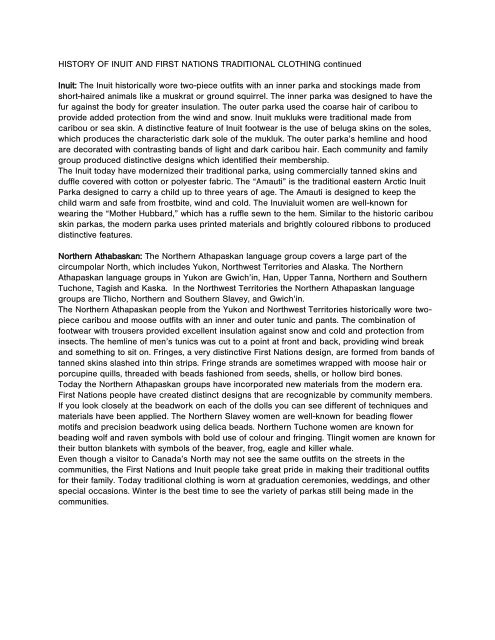Sewing Our Traditions: Dolls of Canada's North Sewing our ...
Sewing Our Traditions: Dolls of Canada's North Sewing our ...
Sewing Our Traditions: Dolls of Canada's North Sewing our ...
You also want an ePaper? Increase the reach of your titles
YUMPU automatically turns print PDFs into web optimized ePapers that Google loves.
HISTORY OF INUIT AND FIRST NATIONS TRADITIONAL CLOTHING continued<br />
Inuit: The Inuit historically wore two-piece outfits with an inner parka and stockings made from<br />
short-haired animals like a muskrat or ground squirrel. The inner parka was designed to have the<br />
fur against the body for greater insulation. The outer parka used the coarse hair <strong>of</strong> caribou to<br />
provide added protection from the wind and snow. Inuit mukluks were traditional made from<br />
caribou or sea skin. A distinctive feature <strong>of</strong> Inuit footwear is the use <strong>of</strong> beluga skins on the soles,<br />
which produces the characteristic dark sole <strong>of</strong> the mukluk. The outer parka’s hemline and hood<br />
are decorated with contrasting bands <strong>of</strong> light and dark caribou hair. Each community and family<br />
group produced distinctive designs which identified their membership.<br />
The Inuit today have modernized their traditional parka, using commercially tanned skins and<br />
duffle covered with cotton or polyester fabric. The “Amauti” is the traditional eastern Arctic Inuit<br />
Parka designed to carry a child up to three years <strong>of</strong> age. The Amauti is designed to keep the<br />
child warm and safe from frostbite, wind and cold. The Inuvialuit women are well-known for<br />
wearing the “Mother Hubbard,” which has a ruffle sewn to the hem. Similar to the historic caribou<br />
skin parkas, the modern parka uses printed materials and brightly col<strong>our</strong>ed ribbons to produced<br />
distinctive features.<br />
<strong>North</strong>ern Athabaskan: The <strong>North</strong>ern Athapaskan language group covers a large part <strong>of</strong> the<br />
circumpolar <strong>North</strong>, which includes Yukon, <strong>North</strong>west Territories and Alaska. The <strong>North</strong>ern<br />
Athapaskan language groups in Yukon are Gwich’in, Han, Upper Tanna, <strong>North</strong>ern and Southern<br />
Tuchone, Tagish and Kaska. In the <strong>North</strong>west Territories the <strong>North</strong>ern Athapaskan language<br />
groups are Tlicho, <strong>North</strong>ern and Southern Slavey, and Gwich’in.<br />
The <strong>North</strong>ern Athapaskan people from the Yukon and <strong>North</strong>west Territories historically wore twopiece<br />
caribou and moose outfits with an inner and outer tunic and pants. The combination <strong>of</strong><br />
footwear with trousers provided excellent insulation against snow and cold and protection from<br />
insects. The hemline <strong>of</strong> men’s tunics was cut to a point at front and back, providing wind break<br />
and something to sit on. Fringes, a very distinctive First Nations design, are formed from bands <strong>of</strong><br />
tanned skins slashed into thin strips. Fringe strands are sometimes wrapped with moose hair or<br />
porcupine quills, threaded with beads fashioned from seeds, shells, or hollow bird bones.<br />
Today the <strong>North</strong>ern Athapaskan groups have incorporated new materials from the modern era.<br />
First Nations people have created distinct designs that are recognizable by community members.<br />
If you look closely at the beadwork on each <strong>of</strong> the dolls you can see different <strong>of</strong> techniques and<br />
materials have been applied. The <strong>North</strong>ern Slavey women are well-known for beading flower<br />
motifs and precision beadwork using delica beads. <strong>North</strong>ern Tuchone women are known for<br />
beading wolf and raven symbols with bold use <strong>of</strong> col<strong>our</strong> and fringing. Tlingit women are known for<br />
their button blankets with symbols <strong>of</strong> the beaver, frog, eagle and killer whale.<br />
Even though a visitor to Canada’s <strong>North</strong> may not see the same outfits on the streets in the<br />
communities, the First Nations and Inuit people take great pride in making their traditional outfits<br />
for their family. Today traditional clothing is worn at graduation ceremonies, weddings, and other<br />
special occasions. Winter is the best time to see the variety <strong>of</strong> parkas still being made in the<br />
communities.








